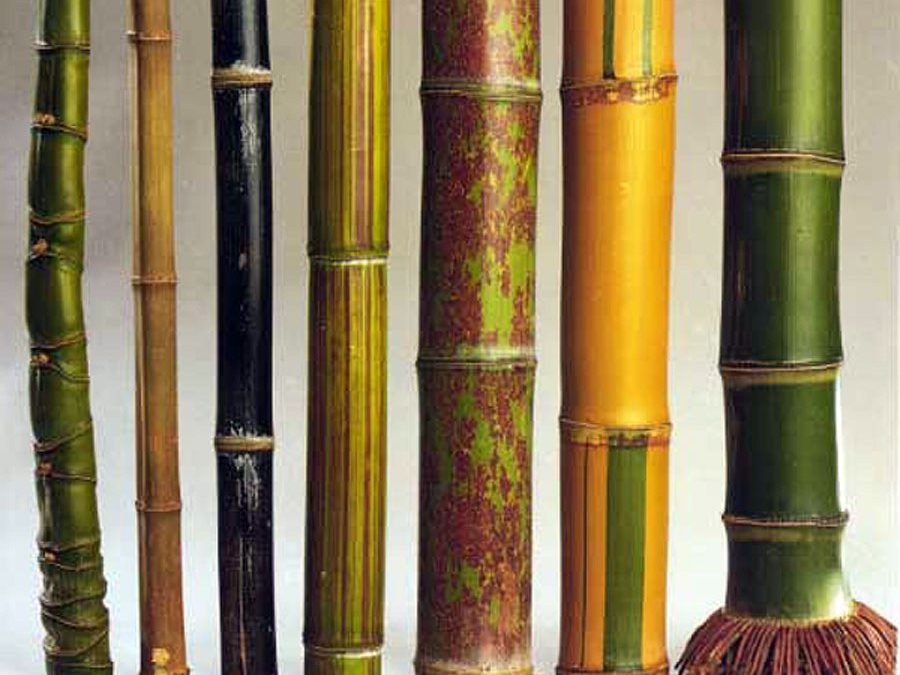The popularity of bamboo is increasing year after year and many incredible stories are told about this plant. But is it all true what they say about bamboo? Does it really grow 1 meter a day? Does bamboo originate from China? On this page you’ll discover all the real facts about bamboo!
1. What is the Origin of the Word “Bamboo”?
The origin of the word Bamboo comes from the Malay word “Mambu”. Malay is the national language of Malaysia and Indonesia. In the late 16th century (1590-1600) the Dutch named it “Bamboes” after which it got its Neo-Latin name “Bambusa”.
Some claim that the original Malayan word was “Bambu”, resembling the sound it makes when bamboo explodes in open fire. When bamboo is heated, the air in the sealed hollow internode chambers will expand and cause an explosive bam-boom sound.
2. Is Bamboo a Tree or a Grass?
Bamboo belongs to the Bambusoideae subfamily of the perennial evergreen grass family Poaceae (Gramineae). It was German Botanist, Charles Kunth, that first published his taxonomic findings in 1815. Of all grasses, bamboo is the largest and the only one that can diversify into forest.
Although bamboo is a grass, many of the larger woody bamboo species are very tree-like in appearance and are often called “bamboo trees”. However, there are a few essential differences between grasses and trees.
Bamboos lack a vascular cambium layer and meristem cells at the top of the culm (stem). The vascular cambium is the perpetually growing layer of a tree’s trunk beneath the bark that makes a tree increase in diameter each year. The meristem cells make the tree grow taller each year.
Bamboos on the other hand do not increase in diameter or height. A single bamboo culm reaches full height in just one growing season. It then persists for several years, gradually increasing the number of side branches and branchlets, but neither growing broader or taller.
Another important difference is that bamboos don’t have a bark as trees do, they have protective leaves around the culm (culm sheaths) in their early stages of development.
3. Where does Bamboo Grow?
Bamboos occur native on 5 continents: Africa, Asia, South America, North America and Australia. In other words all continents except for Antarctica and Europe have bamboo. Coincidentally, all continents except Antarctica and Europe have diamonds.
Bamboos grow in the tropical and subtropical regions of Asia, Africa and Latin America, extending as far north as the southern United States or central China, and as far south as Patagonia. They also grow in northern Australia.
Bamboo is naturally found as secondary vegetation in forests, but in some cases, they are the dominant vegetation type. Such is the case in northeast India where bamboo covers many thousands of square kilometers, and on the mountainsides of eastern Africa.
Bamboos can also tolerate extreme conditions that most plants can’t. Some species can grow from sea level to up to 4000 m in the Andes and Himalayas withstanding temperatures well below -20°C.
4. How Many Bamboo Species are There?
The subfamily Bambusoidaea consists of both woody and herbaceous bamboos with altogether 1575 identified species in 111 different genera.
About 100 species are used commercially, of which 20 are identified as priority species for those wishing to start bamboo plantation. Apart from those commercially important species, many attractive ornamental bamboos are grown in nurseries for landscaping purposes.
5. How Fast does Bamboo Grow?
Measuring Bamboo Growth
Bamboo comprises of many different species which all have unique growth rates and characteristics. Saying that bamboo grows 1 meter a day is misleading as not all bamboo species grow that fast. Therefore, one should always specify the species.
Having said that, Guinness World Records states that the world record for the fastest growing plant on earth belongs to a certain bamboo species that grows up to 91 cm (35”) per day, which is almost 4 cm (1.5”) and hour, or at a speed of 0.00003 km/h (0.00002 mph).
These growth rates can be established in shooting season, and when optimal soil and climate conditions are present. The time-lapse video below for example, also mentions a growth rate of up to 1 meter a day for the Chinese Moso bamboo (Phyllostachys edulis). Another bamboo species which has been reported to have incredible fast growth rates is Madake bamboo (Phyllostachys bambusoides).
6. How Large does Bamboo Grow?
Herbaceous bamboos are usually small and resemble grass and are only a few centimiters tall, while woody bamboos (depending on the species) can grow up to 30 m tall and 20 cm in diameter, hence the reason they are often confused for being “trees”. The bamboo species Dendrocalamus sinicus is considered the largest bamboo in the world reaching 40 m in height and 30 cm in diameter.
7. Bamboo Survived Hiroshima
An extraordinary example of bamboo’s resilience is the fact that it was the only plant to survive the radiation of the atomic bombings in Hiroshima, Japan in 1945. The incinerating heat destroyed all trees and other plant life, except for one bamboo grove. The grove has since been removed, but culms from the grove are preserved in a museum in Hiroshima.
8. Does Bamboo Conduct Electricity?
Light Bulb with Bamboo Filament at the National Museum of American History
Less than a year after he developed the first practical light bulb (1880), Thomas Edison designed a new version that had all the essential features of a modern light bulb; an incandescent filament in an evacuated glass bulb with a screw base.
The most critical factor was finding the right material for the filament, the part inside the light bulb that glows when an electric currant is passed through it. Edison tested more than 1,600 materials, including coconut fiber, fishing line, even hairs from a worker’s beard.
Finally, Edison ended up using bamboo fiber for the filament. Edison and his team discovered that carbonized bamboo had the capacity to conduct electrical currant, and that it could last more than 1200 hours, more than any other material at the time.
Researchers have built upon his work and now have discovered that bamboo charcoal is a natural “nano tube” that can conduct electricity as a very thin film disbursed on the surface of a glass or silicon substrate.
9. Is Lucky Bamboo Really Bamboo?
Lucky Bamboo
The immensely popular ornamental house plant that is believed to bring positive energy and prosperity for those who place it in house or office, is in fact not a bamboo at all!
Lucky bamboo, which originates from the African continent, is widely cultivated in China and Taiwan and exported worldwide. Unlike real bamboos, lucky bamboo grows very slow at about 10 cm annually. The stalks are usually sold when they are between 10 cm and 100 cm tall.
Although the word ‘Bamboo’ occurs in this plant’s common name, its taxonomic order is totally different from real bamboos. The botanical name for Lucky Bamboo is Dracaena braunii (also known as Dracaena sanderiana).


Recent Comments